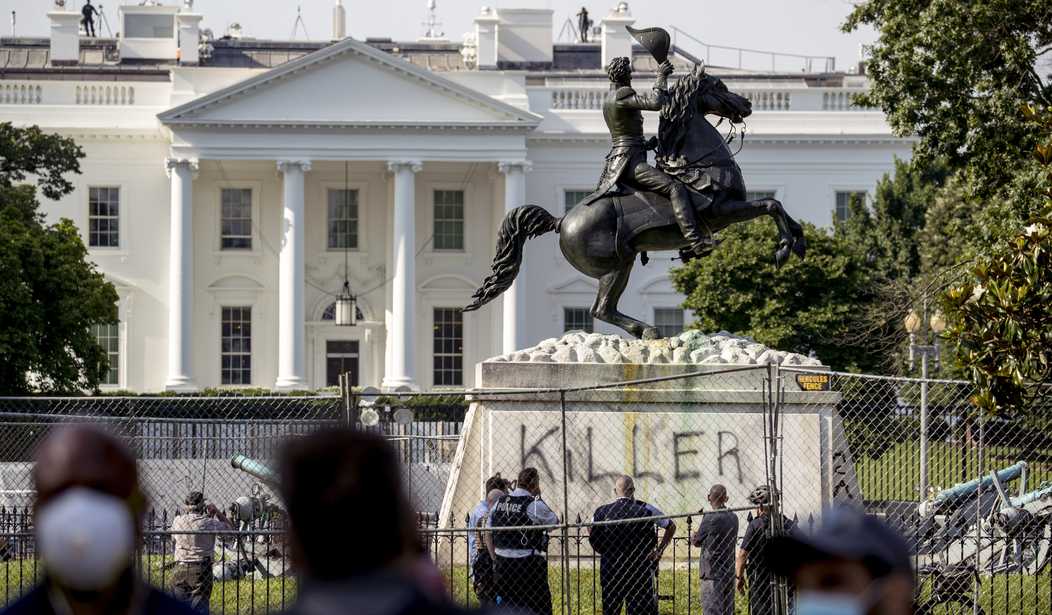The far-Left rioters who attempted to topple the statue of Andrew Jackson in Washington, D.C.’s Lafayette Square Monday night almost certainly know nothing whatsoever about him. What they were told in the Antifa indoctrination camps that are called higher education these days is that he was largely responsible for the forcible exile of Native Americans from the Eastern United States, the Trail of Tears, and is thus to be reviled and hated forever. What they were not told is that Jackson’s rationale for adopting this policy was quite similar to several core Leftist beliefs today.
As Rating America’s Presidents: An America-First Look at Who Is Best, Who Is Overrated, and Who Was An Absolute Disaster explains, Jackson was a foremost advocate for the removal of the Indians from the settled areas of the United States, and their relocation in unsettled areas of the West. In May 1830, he signed the Indian Removal Act that made this recommendation the law of the land. This is today considered to be one of the black marks on his presidency and a shameful period in the history of the United States. This is a reasonable judgment, as this policy amounted to penalizing all Indians for the misdeeds of some Indian warriors, and it led to untold suffering.
It is noteworthy, however, particularly in light of the deep splits in American society today, that Jackson presented his Indian removal plan as beneficial not just for the Americans, but for the Indians as well. In his first annual message to Congress in December 1829, he said: “The condition and ulterior destiny of the Indian tribes within the limits of some of our states have become objects of much interest and importance. It has long been the policy of government to introduce among them the arts of civilization, in the hope of gradually reclaiming them from a wandering life.”
Jackson pointed out that the endeavor to civilize the Indians was inconsistent with the practice of buying Indian land: “This policy has, however, been coupled with another wholly incompatible with its success. Professing a desire to civilize and settle them, we have at the same time lost no opportunity to purchase their lands and thrust them farther into the wilderness. By this means they have not only been kept in a wandering state, but been led to look upon us as unjust and indifferent to their fate. Thus, though lavish in its expenditures upon the subject, government has constantly defeated its own policy, and the Indians in general, receding farther and farther to the west, have retained their savage habits.”
All this is jarring to modern ears. We are told today that the idea that the Indians were not civilized and needed to be is a racist assumption. We are told that to charge them with “savage habits” is likewise ethnocentric and provincial. In the 1960s, 1970s, and thereafter, we were inundated with books and films (such as Bury My Heart at Wounded Knee, Little Big Man, Dances with Wolves, and many others) depicting the Indians as innocent victims of American aggression and imperialism; people who were naturally noble, generous, and open-hearted were oppressed and killed wholesale by rapacious, chauvinistic, sexually repressed white Europeans.
It makes for a good story and is a linchpin of the cultural self-hatred that for decades now has been inculcated assiduously in American youth such as those who tried to topple Jackson’s statue Monday night. But reality, as is always the case when compared with propaganda, is more complicated. The claim that Americans stole the land from the Indians is based on the peculiar assumption that the migration of peoples, war, and conquest, all of which are constants of human history, are always illegitimate. If followed through, this principle would roll back a great deal more than the European settlement of North America.
What’s more, the Indians were indeed waging a war. Jackson had ample reason to refer to the Indians’ “savage habits,” and if any of his hearers opposed his policy, it was not because they disputed that characterization. Indian raids aroused horror in American settlers for decades; U.S. Army Captain Robert G. Carter wrote of the victims of one raid years after Jackson’s presidency that “their fingers, toes, and private parts had been cut off and stuck in their mouths, and their bodies, now lying in several inches of water and swollen or bloated beyond all chance of recognition, were filled full of arrows, which made them resemble porcupines. Upon each exposed abdomen had been placed a mass of live coals…One wretched man, Samuel Elliott, who, fighting hard to the last, had evidently been wounded, was found chained between two wagon wheels and, a fire having been made from the wagon pole, he had been slowly roasted to death—‘burnt to a crisp.’” Those who lived on the frontier in Jackson’s day would not have found any of this unfamiliar.
Jackson’s policy was not to respond in kind to the Indians, but to give them a place where they could flourish. “Our conduct toward these people,” he said in his first message to Congress, “is deeply interesting to our national character. Their present condition, contrasted with what they once were, makes a most powerful appeal to our sympathies.” Noting that some tribes had died out altogether, he asserted that others would disappear also if they continued to live among the Americans. “Humanity and national honor,” he declared, “demand that every effort should be made to avert so great a calamity.” In order to “preserve this much-injured race,” he called for “setting apart an ample district west of the Mississippi, and without the limits of any state or territory now formed, to be guaranteed to the Indian tribes as long as they shall occupy it, each tribe having a distinct control over the portion designated for its use.”
It is ironic that Jackson’s solution is so derided today by the American Left, since it is eminently multicultural: instead of trying to make the Indians into Americans, Jackson proposed that they would have their land and their culture, separate from the land and culture of the Americans. Even the segregationist aspect of Jackson’s plan is modern, for after having been banished from American life, segregation has returned: Wesleyan University, Brown University, MIT, Columbia University, Cornell, Oberlin College, and others, all bastions of multiculturalist orthodoxy, have established segregated dorms in the interest of allowing “marginalized” students to flourish. They and the young people they have so cruelly miseducated could have gotten the idea from a man they hate, Andrew Jackson.
Robert Spencer is the director of Jihad Watch and a Shillman Fellow at the David Horowitz Freedom Center. He is author of 21 books, including the New York Times bestsellers The Politically Incorrect Guide to Islam (and the Crusades) and The Truth About Muhammad. His latest book is Rating America’s Presidents: An America-First Look at Who Is Best, Who Is Overrated, and Who Was An Absolute Disaster. Follow him on Twitter here. Like him on Facebook here.










Join the conversation as a VIP Member